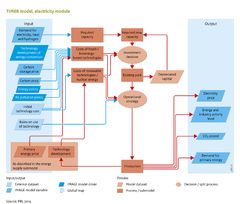Energy conversion: Difference between revisions
Jump to navigation
Jump to search
No edit summary |
No edit summary |
||
| Line 1: | Line 1: | ||
{{ComponentTemplate2 | {{ComponentTemplate2 | ||
|ComponentCode=EC | |ComponentCode=EC | ||
|MainComponent=Energy supply and demand | |MainComponent=Energy supply and demand | ||
|FrameworkElementType=model component | |||
|Status=Publishable | |||
|Application=Resource Efficiency | |Application=Resource Efficiency | ||
|IMAGEComponent=Energy supply and demand; Energy demand; Energy supply; Land use allocation-Agricultural systems; Climate policy; Drivers; | |IMAGEComponent=Energy supply and demand; Energy demand; Energy supply; Land use allocation-Agricultural systems; Climate policy; Drivers; | ||
|KeyReference=Hoogwijk et al., 2007; Hendriks et al., 2004; | |KeyReference=Hoogwijk et al., 2007; Hendriks et al., 2004; | ||
|InputVar=Technology development; Energy policies; Air pollution policies; Demand for electricity and hydrogen; Primary energy price; Carbon storage cost; Carbon price | |InputVar=Technology development; Energy policies; Air pollution policies; Demand for electricity and hydrogen; Primary energy price; Carbon storage cost; Carbon price; | ||
|OutputVar=Electricity price; Demand for primary energy; CO2 stored; Activity level; | |||
|OutputVar=Electricity price; Demand for primary energy; CO2 stored; Activity level; | |Parameter=Initial technology cost; Rules on use technologies; | ||
| | |Description=Energy from primary sources often is first converted into secondary energy carriers that are more easily accessible for final consumption. Examples of such conversion processes relate to the production of electricity and hydrogen, oil products from crude oil in refineries, and the production of fuels from biomass. Electricity (and in the future possibly also hydrogen) is produced by the conversion of primary energy carriers, such as fossil fuels, fissile materials (uranium), and various renewable energy sources. Studies on transitions towards more sustainable energy systems tend to show the importance of these conversions for the future. | ||
|Description= | |||
In two steps, the conversion models in the IMAGE Energy model simulate the choices made between input energy carriers. In the first step, at the level of newly added capital, investment decisions are made on the future generation mix. In the second step, the actual operationuse of the capacity in place depends on a set of model rules that determine how often the different types of power plants are used. and for what purpose (baseload/peakload). The discussion here concentrates on the production of electricity and hydrogen. Other conversion processes are relatively simple, as they mostly convert energy from a single primary source to one secondary energy carrier; these are therefore discussed in the [[Energy supply|primary energy (sub)model]]. | |||
|Flowchart=FlowDiagramElectrictyModel.png | |Flowchart=FlowDiagramElectrictyModel.png | ||
|CaptionText=Flow diagram Elecricity Model | |CaptionText=Flow diagram Elecricity Model | ||
|AltText=Flow diagram Elecricity Model | |AltText=Flow diagram Elecricity Model | ||
}} | }} | ||
Revision as of 12:42, 18 November 2013
Parts of Energy conversion
| Component is implemented in: |
|
| Related IMAGE components |
| Projects/Applications |
| Models/Databases |
| Key publications |
Key policy issues
- What is the potential role of energy conversion sector, particularly in power production, in achieving a more sustainable energy system?
- What are the potential roles of individual technologies, such as carbon capture and storage (CCS), nuclear power, hydrogen and renewable energy?
Introduction
"model component" is not in the list (driver component, pressure component, interaction component, state component, impact component, response component) of allowed values for the "FrameworkElementType" property.
